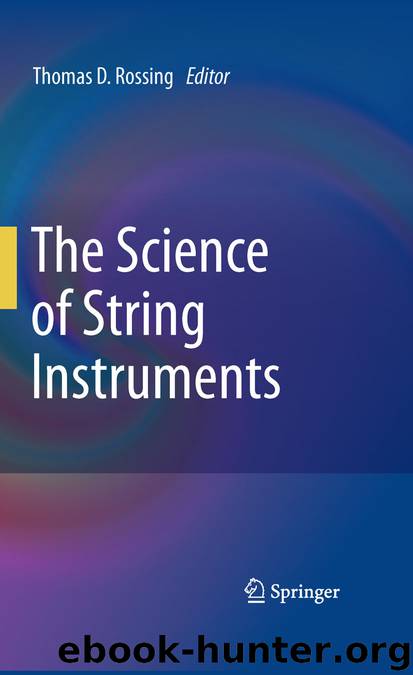The Science of String Instruments by Thomas Rossing

Author:Thomas Rossing [Rossing, Thomas]
Language: eng
Format: epub
Tags: Mechanics, Technology & Engineering, Art, Acoustics & Sound, Waves & Wave Mechanics, Science, General, Musical Instruments, Music, Mechanical, Dynamics, Physics, Strings
ISBN: 9781441971104
Google: 8yQ_XHh53HUC
Publisher: Springer Science & Business Media
Published: 2010-12-15T21:20:13+00:00
13.11 Measuring Sound Radiation
Under normal playing conditions, a violin produces sound in response to the string force at the bridge. For measurement purposes, a transducer typically applies the force, while one or more microphones pick up the sound. A transfer function between microphone and driver signals yields the frequency response in terms of sound pressure at the microphone position, per-unit-force at the bridge, a measure of what Weinreich has termed radiativity.
Many possible radiation measurements can be made for a given violin. The bridge can be excited at different driving points and in different directions, and each will excite a different balance of body modes. Because of increasingly directional radiation above about 1 kHz, shifting the microphone position can significantly change the measurements. Furthermore, the response of the instrument itself may change with temperature and humidity, and then there are the complicating effects of room acoustics. All this makes it difficult to measure violin sound radiation in a comprehensive way. Instead, researchers rely on a number of simplifications. The bridge is generally excited with a lateral force, while a limited number of microphone positions are used to sample the sound field. Langhoff (1994) found that eight positions provided a good estimate of total radiation. Schleske (2002) used 36, spaced evenly around the instrument in the plane of the bridge; Bissinger (2008) used 266, arranged spherically.
Many excitation methods have been employed, including bowing machines and electromagnetic bridge drivers. For purposes of illustration, we will consider some results obtained with an impact hammer. Figure 13.11 shows the equipment used. The hammer taps the bass corner of the bridge, while a sensor in its tip records the force waveform of the blow. The microphone, which can be moved 360° around the instrument, is held in the plane of the bridge at 37 cm from the central axis of the instrument, here defined as a line rising vertically through the end-pin. To increase the signal-to-noise ratio, the complex average of several impacts is taken for each microphone position. The measurements cited below are all for a single, good-quality, modern violin. To avoid problems with reflected sound, measuring was done in an anechoic chamber. Twelve microphone positions were used, one directly in front of the bridge, the others spaced at 30° intervals around the instrument.
Fig. 13.11Apparatus for measuring sound radiation using an impact hammer. It can be set up in a violin maker’s workshop
Download
This site does not store any files on its server. We only index and link to content provided by other sites. Please contact the content providers to delete copyright contents if any and email us, we'll remove relevant links or contents immediately.
The Complete Stick Figure Physics Tutorials by Allen Sarah(7127)
Secrets of Antigravity Propulsion: Tesla, UFOs, and Classified Aerospace Technology by Ph.D. Paul A. Laviolette(4965)
Thing Explainer by Randall Munroe(3779)
The River of Consciousness by Oliver Sacks(3403)
The Order of Time by Carlo Rovelli(3068)
How To by Randall Munroe(2909)
I Live in the Future & Here's How It Works by Nick Bilton(2836)
A Brief History of Time by Stephen Hawking(2815)
What If?: Serious Scientific Answers to Absurd Hypothetical Questions by Randall Munroe(2541)
The Great Unknown by Marcus du Sautoy(2530)
Midnight in Chernobyl by Adam Higginbotham(2376)
Blockchain: Ultimate Step By Step Guide To Understanding Blockchain Technology, Bitcoin Creation, and the future of Money (Novice to Expert) by Keizer Söze(2374)
Networks: An Introduction by Newman Mark(2259)
The Meaning of it All by Richard Feynman(2208)
Easy Electronics by Charles Platt(2203)
The Tao of Physics by Fritjof Capra(2160)
Midnight in Chernobyl: The Untold Story of the World's Greatest Nuclear Disaster by Adam Higginbotham(2068)
When by Daniel H Pink(2018)
Introducing Relativity by Bruce Bassett(2012)
